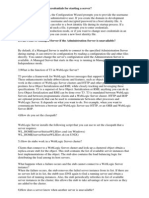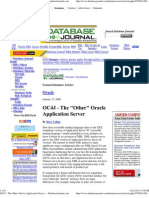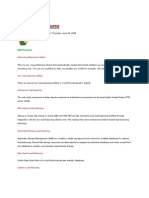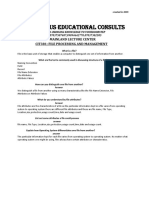Weblogic Server-Tips & Tricks For Troubleshooting Performance Issues
Weblogic Server-Tips & Tricks For Troubleshooting Performance Issues
Uploaded by
Nageshwara raoCopyright:
Available Formats
Weblogic Server-Tips & Tricks For Troubleshooting Performance Issues
Weblogic Server-Tips & Tricks For Troubleshooting Performance Issues
Uploaded by
Nageshwara raoOriginal Description:
Original Title
Copyright
Available Formats
Share this document
Did you find this document useful?
Is this content inappropriate?
Copyright:
Available Formats
Weblogic Server-Tips & Tricks For Troubleshooting Performance Issues
Weblogic Server-Tips & Tricks For Troubleshooting Performance Issues
Uploaded by
Nageshwara raoCopyright:
Available Formats
WebLogic Server- Tips & Tricks for
Troubleshooting Performance Issues
By: Abhay Kumar
AST Corporation
March 1st, 2016
Contents
INTRODUCTION ..................................................................... 3
UNDERSTAND YOUR PERFORMANCE OBJECTIVES AND SET REALISTIC
GOALS ....................................................................... 3
MEASURE YOUR PERFORMANCE METRICS ........................... 3
TOP TUNING RECOMMENDATIONS ...................................... 4
TUNE POOL SIZE .................................................................... 4
THREAD MANAGEMENT........................................................ 4
TUNING NETWORK I/O .......................................................... 5
TUNING DATASOURCES......................................................... 5
TUNING TRANSACTIONS ....................................................... 5
WEBLOGIC CLUSTERS ............................................................ 6
TUNE PERSISTENT STORES .................................................... 6
USE BEST DESIGN PRACTICES ................................................ 6
CONCLUSION ......................................................................... 6
Weblogic Server-Performance tuning tips & ticks
Page ii
Introduction
Oracle WebLogic Server is the #1 application server across
conventional and cloud environments. With Oracle WebLogic
we can deliver next-generation applications on a mission-critical
cloud platform, simplify operations with native cloud
management, and accelerate time to market with a modern
development platform and integrated tools. WebLogic Server is
the industry's best application server for building and deploying
There is no enterprise Java EE applications with support for new features for
lowering cost of operations, improving performance, enhancing
magical wand to scalability and supporting the Oracle Applications portfolio.
tune the Weblogic Performance tuning WebLogic Server and your WebLogic
Server application is a complex and iterative process. This paper
server. It is a will provide tips to get you started, and provide a short list of
recommendations to help you optimize your application’s
complex and performance.
iterative process
UNDERSTAND YOUR PERFO RMANCE OBJECTIVES AN D SET
REALISTIC GOALS
Understand your deployed application- Bad Design can
never be a good candidate for performance tuning
Find out the number of users using the system.
Find out the number of requests on the system.
The amount of data flowing in/out of the system.
Determine the target CPU Utilization- Should not be
100%.
MEASURE YOUR PERFORMANCE METRICS
Take measurements of metrics which will be used to quantify the
performance goals.
Monitor Application Server (CPU and Disk)
Monitor Database Server(CPU and Disk)
Monitor data transfer across networks
Locate bottlenecks and break them.
Weblogic Server-Performance tuning
Page 3
TOP TUNING RECOMMENDATIONS
Following is the list of recommendations for performance
tuning.
Tune Application- Overly-complex or poorly-
designed applications will perform poorly regardless of
the system-level tuning and best practices employed to
improve performance.
Tune DB - Database can be a major enterprise-
level bottleneck. Database optimization can be complex
and vender dependent.
Tune WebLogic Server Performance Parameters-
The WebLogic Server uses a number of OOTB (out-of-
the-box) performance-related parameters that can be
fine-tuned depending on your environment and
applications. Tuning these parameters based on your
system can greatly improve both single-node
performance and the scalability characteristics of an
application.
Tune Your JVM - The Java virtual machine (JVM) is a
virtual "execution engine" instance that executes the
bytecodes in Java class files on a microprocessor.
Tune the Operating System - Each operating system sets
default tuning parameters differently. For Windows
platforms, the default settings are usually sufficient.
However, the UNIX and Linux operating systems
usually need to be tuned appropriately.
TUNE POOL SIZE
Provide pool sizes (such as pools for JDBC connections,
Stateless Session EJBs, and MDBs) that maximize concurrency
for the expected thread utilization. In general, the number of
connections should equal the number of threads that are expected
to be required to process the requests handled by the pool. The
most effective way to ensure the right pool size is to monitor it
and make sure it does not shrink and grow.
THREAD MANAGEMENT
WebLogic Server provides the following mechanisms to manage
threads to perform work.
Tuning a Work Manager: Tune the thread utilization of a
server instance by defining rules and constraints for your
application by defining a Work Manger.
Tuning the Stuck Thread Detection Behavior: WebLogic
Server automatically detects when a thread in an execute queue
Weblogic Server-Performance tuning
Page 4
becomes "stuck." Because a stuck thread cannot complete its
current work or accept new work, the server logs a message each
time it diagnoses a stuck thread. WebLogic Server diagnoses a
thread as stuck if it is continually working (not idle) for a set
period of time. You can tune a server's thread detection behavior
by changing the length of time before a thread is diagnosed as
stuck, and by changing the frequency with which the server
checks for stuck threads.
TUNING NETWORK I/O
Network channels are also known as network access points.
These access points let us specify variant quality of service
parameters for network communication. The major role of a
channel is to control the network traffic for a server. But we can
leverage the capacity to build multiple custom channels to
acknowledge a multi-threaded client to interact with server
instances over multiple connections. So this helps in reducing the
potential for a bottleneck.
TUNING DATASOURCES
An easy way to boost performance of a data source in WebLogic
Server applications is to set the value of Initial Capacity equal to
the value for Maximum Capacity when configuring connection
pools in your data source. Cache JNDI connections. Use Test
Connections on Reserve with Care.
TUNING TRANSACTIONS
Typical two-phase transactions in JMS applications usually
involve both a JMS server and a database server. The LLR
option can as much as double performance compared to
XA.The safety of the JDBC LLR option contrasts with well-
known but less-safe XA optimizations such as "last-agent",
"last-participant", and "emulate-two-phase-commit" that are
available from other vendors as well as WebLogic.JDBC LLR
works by storing two-phase transaction records in a database
table rather than in the transaction manager log (the TLOG).
Weblogic Server-Performance tuning
Page 5
WEBLOGIC CLUSTERS
A weblogic Server cluster is a group of WebLogic Servers
instances that together provide fail-over and replicated services
to support scalable high-availability operations for clients within
a domain. A cluster appears to its clients as a single server but is
in fact a group of servers acting as one to provide increased
scalability and reliability.
TUNE PERSISTENT STORES
For subsystems that share the same server instance, share one
store between multiple subsystems rather than using a store per
subsystem. Sharing a store is more efficient for the following
reasons:
A single store batches concurrent requests into single
I/Os which reduces overall disk usage.
Transactions in which only one resource participates are
lightweight one-phase transactions. Conversely,
transactions in which multiple stores participate become
heavier weight two-phase transactions.
Add a new store only when the old store(s) no longer
scale.
Under heavy JDBC store I/O loads, you can improve
performance by configuring a JDBC store to use
multiple JDBC connections to concurrently process I/O
operations.
USE BEST DESIGN PRACTICES
Most performance gains or losses in a database application is not
determined by the application language, but by how the
application is designed. The number and location of clients, size
and structure of DBMS tables and indexes, and the number and
types of queries all affect application performance.
Conclusion
This white paper provides some input on the major performance
tuning considerations for WebLogic Server. However keep
following things in mind:
Performance tuning is not a silver bullet. Simply put,
good system performance depends on: good design,
good implementation, defined performance objectives,
and performance tuning.
Performance tuning is ongoing process. Implement
Weblogic Server-Performance tuning
Page 6
mechanisms that provide performance metrics which
you can compare against your performance objectives,
allowing you to schedule a tuning phase before your
system fails.
The object is to meet your performance objectives, not
eliminate all bottlenecks. Resources within a system are
finite. By definition, at least one resource (CPU,
memory, or I/O) will be a bottleneck in the system.
Tuning allows you minimize the impact of bottlenecks
on your performance objectives.
Design your applications with performance in mind.
o Keep things simple - avoid inappropriate use of
published patterns.
o Apply Java EE performance patterns.
o Optimize your Java code.
Weblogic Server-Performance tuning
Page 7
You might also like
- 3HE17250AAAATQZZA - V1 - NSP NFM-P 21.3 XML API Developer GuideDocument366 pages3HE17250AAAATQZZA - V1 - NSP NFM-P 21.3 XML API Developer Guidedd100% (1)
- Online Job Search SystemDocument43 pagesOnline Job Search SystemNikita Kesharwani100% (1)
- DB Replay White Paper Ow07 1-2-133325Document19 pagesDB Replay White Paper Ow07 1-2-133325IgorNo ratings yet
- 3par - Training Day 1Document71 pages3par - Training Day 1purush_123No ratings yet
- Websphere Application ServerDocument6 pagesWebsphere Application Serverminnu_156No ratings yet
- Capacity Planning Guide For Weblogic Portal 10.3.2Document24 pagesCapacity Planning Guide For Weblogic Portal 10.3.2docphongm41No ratings yet
- Websphere Interview QuestionsDocument5 pagesWebsphere Interview Questions@vjNo ratings yet
- Sail Point Interview QuestionsDocument3 pagesSail Point Interview QuestionsjeffNo ratings yet
- Final - Network Load BalancingDocument67 pagesFinal - Network Load BalancingNameNo ratings yet
- Oracle Analytics Server Infrastructure Tuning Guide v2Document40 pagesOracle Analytics Server Infrastructure Tuning Guide v2KnNo ratings yet
- Oracleas10g Best Appserver For Oracle Database WPDocument18 pagesOracleas10g Best Appserver For Oracle Database WPEmrah BaşaranNo ratings yet
- DBCC, DMVs and PT Q&ADocument12 pagesDBCC, DMVs and PT Q&AAsim KhanNo ratings yet
- Configuring The Server For Optimal Performance: Course: Database Administration Effective Period: September 2017Document35 pagesConfiguring The Server For Optimal Performance: Course: Database Administration Effective Period: September 2017Venus DhammikoNo ratings yet
- TWP Rac Compare Sqlserver2005 130279Document14 pagesTWP Rac Compare Sqlserver2005 130279Abby JenningsNo ratings yet
- 10 Performance Bottlenecks in Web ApplicationDocument7 pages10 Performance Bottlenecks in Web ApplicationPathuri Naganjaneya ReddyNo ratings yet
- Comparing Couchbase Server 3.0.2 With Mongodb 3.0: Benchmark Results and AnalysisDocument15 pagesComparing Couchbase Server 3.0.2 With Mongodb 3.0: Benchmark Results and Analysismf1987irNo ratings yet
- Monitoring and Administering DatabaseDocument15 pagesMonitoring and Administering DatabaseAliyan AmanNo ratings yet
- 000 Basics and IntroductionDocument7 pages000 Basics and IntroductionsureshtNo ratings yet
- Oo Soln Webcenter 11g 170243Document23 pagesOo Soln Webcenter 11g 170243Syed Zeeshan Haider ShahNo ratings yet
- Oracle Weblogic Suite 11G Benefit Your Business With Fast, Efficient MiddlewareDocument11 pagesOracle Weblogic Suite 11G Benefit Your Business With Fast, Efficient MiddlewareLamenew NiboNo ratings yet
- PeopleSoft Performance TuningDocument9 pagesPeopleSoft Performance Tuningrmalhotra86No ratings yet
- MS SQL Server 2005 Interview Questions and AnswersDocument11 pagesMS SQL Server 2005 Interview Questions and Answersjayasankar_2010No ratings yet
- OBIEE 11 1 1 7 Tuning Guide Revision v4 01-2014Document72 pagesOBIEE 11 1 1 7 Tuning Guide Revision v4 01-2014Yaswanth RamisettyNo ratings yet
- Performance TestingDocument20 pagesPerformance Testingcepl34No ratings yet
- Optimization EbsDocument87 pagesOptimization EbsKamel KhelifiNo ratings yet
- Best Practice Document For Creating BEx Query and Workbook Version 1 (1) .0Document19 pagesBest Practice Document For Creating BEx Query and Workbook Version 1 (1) .0deba_23No ratings yet
- Batch Processing With J2EE Design, Architecture and PerformanceDocument137 pagesBatch Processing With J2EE Design, Architecture and PerformanceRabi ShankarNo ratings yet
- 0909 BlytheDocument39 pages0909 BlythepiqouskerberosNo ratings yet
- AnswerDocument4 pagesAnswerFernando SalasNo ratings yet
- Developer and DBA Tips For Pro-Actively Optimizing SQL Apply Performance PDFDocument16 pagesDeveloper and DBA Tips For Pro-Actively Optimizing SQL Apply Performance PDFThana Balan SathneeganandanNo ratings yet
- Stored Procedures2Document8 pagesStored Procedures2api-3782519No ratings yet
- Weblogic Interview QuestionsDocument4 pagesWeblogic Interview Questionsharshvardhan05No ratings yet
- Benchmarking Servers Using Virtual MachinesDocument18 pagesBenchmarking Servers Using Virtual MachinesantonskatelbjbNo ratings yet
- Oracle WebLogic Server 12c Performance Tuning WorkshopDocument3 pagesOracle WebLogic Server 12c Performance Tuning WorkshopnizamNo ratings yet
- Weblogic Interview QuestionsDocument4 pagesWeblogic Interview QuestionsAvijit ChakrabortyNo ratings yet
- SQL Server 2012Document73 pagesSQL Server 2012Anonymous iUW0JL6O5No ratings yet
- Soa Admin Faq'S - With AnsDocument125 pagesSoa Admin Faq'S - With AnsKumar SwamyNo ratings yet
- B2Bi On PureScaleDocument18 pagesB2Bi On PureScalenaruforu2005No ratings yet
- OC4J - The 'Other' Oracle Application Server - DatabaseJournalDocument9 pagesOC4J - The 'Other' Oracle Application Server - DatabaseJournalchoudhary.mahendra@gmail.comNo ratings yet
- Oracle Pass4sure 1z0-599 v2015-03-14 by Elenora 75qDocument56 pagesOracle Pass4sure 1z0-599 v2015-03-14 by Elenora 75qIrving Esteban GuerreroNo ratings yet
- Oracle Weblogic Suite 11G: Key Features and BenefitsDocument3 pagesOracle Weblogic Suite 11G: Key Features and BenefitsRoniHidayatNo ratings yet
- What - S New in DataStage 8 - FINALDocument5 pagesWhat - S New in DataStage 8 - FINALKeshavardhan ReddyNo ratings yet
- Toaz - Info Automobile Shop Management System PRDocument82 pagesToaz - Info Automobile Shop Management System PRjujubershaikh36No ratings yet
- SQL Server ReplicationDocument8 pagesSQL Server Replicationrajaprabu_p7821No ratings yet
- 037 Query Optimization in Oracle (9 Oldal)Document9 pages037 Query Optimization in Oracle (9 Oldal)Eid TahirNo ratings yet
- Oracle 11g FeaturesoDocument10 pagesOracle 11g FeaturesoNagarajuNo ratings yet
- Scaling Siebel CRM Solutions With Oracle 10g RAC: James Qiu, Anda ZhaoDocument18 pagesScaling Siebel CRM Solutions With Oracle 10g RAC: James Qiu, Anda ZhaoWazzupdude101No ratings yet
- Oracle Database 11G Standard Edition & Standard Edition One: Your #1 Choice For Performance, Scalability and SecurityDocument2 pagesOracle Database 11G Standard Edition & Standard Edition One: Your #1 Choice For Performance, Scalability and SecurityMarino MorenoNo ratings yet
- Basic Database Performance Tuning - Developer's Perspective: Michal KwiatekDocument6 pagesBasic Database Performance Tuning - Developer's Perspective: Michal KwiatekMohd YasinNo ratings yet
- SQL Server Interview Questions - Advantages of Stored ProceduresDocument3 pagesSQL Server Interview Questions - Advantages of Stored Proceduresparashuram nNo ratings yet
- 04 RPRTDocument55 pages04 RPRTgaykwad0102No ratings yet
- WP 19c Rat emDocument10 pagesWP 19c Rat emUdayanNo ratings yet
- Experiment:-1 Objective:-Introduction To Component. What Is Components?Document13 pagesExperiment:-1 Objective:-Introduction To Component. What Is Components?Pradyumna MittalNo ratings yet
- Nginx Vs Apache: Application Server Web ServerDocument6 pagesNginx Vs Apache: Application Server Web ServerManish KumarNo ratings yet
- High Performance SQL Server: Consistent Response for Mission-Critical ApplicationsFrom EverandHigh Performance SQL Server: Consistent Response for Mission-Critical ApplicationsNo ratings yet
- R2DBC Revealed: Reactive Relational Database Connectivity for Java and JVM ProgrammersFrom EverandR2DBC Revealed: Reactive Relational Database Connectivity for Java and JVM ProgrammersNo ratings yet
- SQL Server Query Tuning and Optimization: Optimize Microsoft SQL Server 2022 queries and applicationsFrom EverandSQL Server Query Tuning and Optimization: Optimize Microsoft SQL Server 2022 queries and applicationsNo ratings yet
- SQL Server Interview Questions You'll Most Likely Be AskedFrom EverandSQL Server Interview Questions You'll Most Likely Be AskedNo ratings yet
- Quiz OS&CNDocument28 pagesQuiz OS&CNNguyễn Quang Vũ40% (5)
- Computer Hardware N SoftwareDocument21 pagesComputer Hardware N SoftwareTatendah ChamapiwaNo ratings yet
- SysDiag CPU EngDocument2 pagesSysDiag CPU EngsybaritzNo ratings yet
- Unit - 1 Module 2Document62 pagesUnit - 1 Module 2Kashish VermaNo ratings yet
- Operating System Structures (Chapter 2) : ReferencesDocument20 pagesOperating System Structures (Chapter 2) : ReferencesSudip Kumar DeyNo ratings yet
- ICT Material-1 (2019-2020)Document85 pagesICT Material-1 (2019-2020)Teller PersonNo ratings yet
- Cit381 Calculus Educational Consult 2021 - 1Document43 pagesCit381 Calculus Educational Consult 2021 - 1Temiloluwa IbrahimNo ratings yet
- Lecture - 07 - Embedded Systems Software IntroductionDocument25 pagesLecture - 07 - Embedded Systems Software IntroductionTú Phạm AnhNo ratings yet
- Fianl Essay of OMDocument4 pagesFianl Essay of OMApurbo Sarkar ShohagNo ratings yet
- Robert F. NiemoellerDocument4 pagesRobert F. NiemoellerPhaniVenkatNo ratings yet
- CSE4011 - Module 2 - 1Document18 pagesCSE4011 - Module 2 - 1SiddhantpsinghNo ratings yet
- SRS Template For Java Chat AppDocument13 pagesSRS Template For Java Chat Appshubhambindal73% (11)
- PANASONIC DMR-EH55 Firmware InstallDocument8 pagesPANASONIC DMR-EH55 Firmware InstallnekimailyNo ratings yet
- 2022 Microprocessor and InterfacingDocument10 pages2022 Microprocessor and InterfacingYash GuptaNo ratings yet
- MDS G012aaDocument20 pagesMDS G012aajjyotiNo ratings yet
- Online Railway Reservation SystemDocument22 pagesOnline Railway Reservation SystemZobiaAziz100% (2)
- ASD Top 4 Mitigation Strategies - List of Software - This Component Provides A Common Application Vendors - Vulnerability Summary - This Component DisplaysDocument2 pagesASD Top 4 Mitigation Strategies - List of Software - This Component Provides A Common Application Vendors - Vulnerability Summary - This Component DisplaysIreneNo ratings yet
- Bsitay2018 PDFDocument2 pagesBsitay2018 PDFDavidNo ratings yet
- BCA Syllabus FullDocument20 pagesBCA Syllabus FullJitendriya SahuNo ratings yet
- I-Series SecurityDocument198 pagesI-Series Securityapi-27605687No ratings yet
- Evolution of OS: 1. Batch Operating SystemDocument5 pagesEvolution of OS: 1. Batch Operating SystemmamtaNo ratings yet
- Intel - Build Your Own Cluster With Open Source Software and Intel HardwareDocument111 pagesIntel - Build Your Own Cluster With Open Source Software and Intel HardwareMarko KobalNo ratings yet
- IT Essentials A 2002Document82 pagesIT Essentials A 2002reza supriatnaNo ratings yet
- Past PaperDocument3 pagesPast PaperLelelit Sidai SilvioNo ratings yet
- Gaurav - C++ ResumeDocument11 pagesGaurav - C++ ResumeGaurav ChandraNo ratings yet
- InteliVision 18touch DatasheetDocument4 pagesInteliVision 18touch DatasheetArchie MaguillanoNo ratings yet
- OVM Manager 2 2 User GuideDocument154 pagesOVM Manager 2 2 User Guidea23780No ratings yet
- IT Essentials ITE v6.0 Checkpoint Exam Answers 100 2016 PDFDocument10 pagesIT Essentials ITE v6.0 Checkpoint Exam Answers 100 2016 PDFArogundade Segun VictorNo ratings yet

























































































